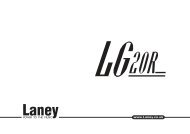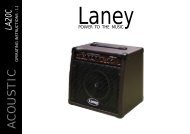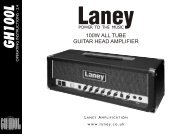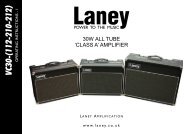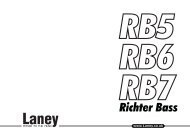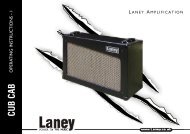TI100 User Manual_2012_Black Cover__Issue 1.3.cdr - Laney
TI100 User Manual_2012_Black Cover__Issue 1.3.cdr - Laney
TI100 User Manual_2012_Black Cover__Issue 1.3.cdr - Laney
- No tags were found...
Create successful ePaper yourself
Turn your PDF publications into a flip-book with our unique Google optimized e-Paper software.
ATTENTION: L’utilisation de tout appareil électrique doit être soumise aux precautions d’usage incluant:1. Lire ces instructions2. Gardez ce manuel pour de futures références.3. Prétez attention aux messages de précautions de ce manuel.4. Suivez ces instructions.5. N’utilisez pas cette unité proche de plans d’eau.6. N’utilisez qu’un tissu sec pour le nettoyage de votre unité.7. N’obstruez pas les systèmes de refroidissement de votre unité et installez votre unité en fonction des instructionsde ce manuel.8. Ne positionnez pas votre unité à proximité de toute source de chaleur.9. Un appareil avec la construction de la classe I sera relié à une sortie de douille de forces à un raccordement protecteur. Connectez toujours votre unitésur une alimentation munie de prise de terre utilisant le cordon d’alimentation fourni.10. Protégez les connecteurs de votre unité et positionnez les cablages pour éviter toutes déconnexions accidentelles.11. N’utilisez que des fixations approuvées par le fabriquant.12. Lors de l’utilsation sur pied ou pole de support, assurez dans le cas de déplacement de l’ensemble enceinte/support de prévenir tout basculementintempestif de celui-ci.13. Les forces branchent ou le coupleur d'appareils est utilisé pendant que le dispositif de débranchement et restera aisément fonctionnel. L'utilisateurdevrait permettre l'accès facile à toutes les forces prise, à forces coupleur et à commutateur de forces utilisé en même temps que cette unité le rendant dece fait aisément fonctionnel. Débranchez cet appareil pendant la foudre donne l' assaut à ou si inutilisé pendant de longues périodes.14. Seul un technicien agréé par le fabriquant est à même de réparer/contrôler votre unité. Celle-ci doit être contrôlée si elle a subit des dommages demanipulation, d’utilisation ou de stockage (humidité,…).15. Ne déconnectez jamais la prise de terre de votre unité.16. Si votre unité est destinée a etre montée en rack, des supports arriere doivent etre utilises.17. Note pour les Royaumes-Unis: Si les couleurs de connecteurs du cable d’alimentation ne correspond pas au guide de la prise secteur, procédez commesuit:a) Le connecteur vert et jaune doit être connectrer au terminal noté E, indiquant la prise de terre ou correspondantaux couleurs verte ou verte etjaune du guide.b) Le connecteur bleu doit être connectrer au terminal noté N, correspondnat à la couleur noire du guide.c) Le connecteur marron doit être connectrer au terminal noté L, correspondant à la couleur rouge du guide.18. Cet équipement électrique ne doit en aucun cas être en contact avec un quelconque liquide et aucun objetcontenant un liquide, vase ou autre ne devrait être posé sur celui-ci.19. Une exposition à de hauts niveaux sonores peut conduire à des dommages de l’écoute irréversibles. Lasusceptibilité au bruit varie considérablement d’un individu à l’autre, mais une large majorité de la populationexpériencera une perte de l’écoute après une exposition à une forte puissance sonore pour une durée prolongée.L’organisme de la santé américaine (OSHA) a produit le guide ci-dessous en rapport à la perte occasionnée:D’après les études menées par le OSHA, toute exposition au delà des limites décrites ce-dessus entrainera despertes de l’écoute chez la plupart des sujets. Le port de système de protection (casque, oreilette de filtrage,…) doitêtre observé lors de l’opération cette unité ou des dommages irréversibles peuvent être occasionnés. Le port de cessystèmes doit être observé par toutes personnes susceptibles d’être exposées à des conditions au delà des limitesdécrites ci-dessus.
ACHTUNG: Beim Einsatz von Elektrogeräten müssen u.a. grundlegende Vorsichtsmaßnahmen befolgt werden:1. Lesen Sie sich diese Anweisungen durch.2. Bewahren Sie diese Anweisungen auf.3. Beachten Sie alle Warnungen.4. Befolgen Sie alle Anweisungen.5. Setzen Sie dieses Gerät nicht in der Nähe von Wasser ein.6. Reinigen Sie es nur mit einem trockenen Tuch.7. Blockieren Sie keine der Lüftungsöffnungen. Führen Sie die Installation gemäß den Anweisungen des Herstellers durch.8. Installieren Sie das Gerät nicht neben Wärmequellen wie Heizungen, Heizgeräten, Öfen oder anderen Geräten (auch Verstärkern), die Wärme erzeugen.9. Ein Apparat mit Aufbau der Kategorie I wird an einen Hauptleitungseinfaßungsanschluß mit einem schützenden Anschluss angeschlossen.Beeinträchtigen Sie nicht die Sicherheitswirkung des gepolten Steckers bzw. des Erdungssteckers. Ein gepolter Stecker weistzwei Stifte auf, von denen einer breiterist als der andere. Ein Erdungsstecker weist zwei Stifte und einen dritten Erdungsstift auf.Der breite Stift bzw. der dritte Stift dient Ihrer Sicherheit. Sollte derbeiliegende Stecker nicht in Ihre Steckdose passen, wenden Sie sich bitte an einen Elektriker, um die ungeeignete Steckdose austauschen zu lassen.10. Schützen Sie das Netzkabel, sodass niemand darauf tritt oder es geknickt wird, insbesondere an Steckern oder Buchsen und ihren Austrittsstellen aus dem Gerät.11. Verwenden Sie nur die vom Hersteller erhältlichen Zubehörgeräte oder Zubehörteile.12. Verwenden Sie nur einen Wagen, Stativ, Dreifuß, Träger oder Tisch, der den Angaben des Herstellers entspricht oder zusammen mit dem Gerät verkauft wurde.Wird ein Wagen verwendet, bewegen Sie den Wagen mit dem darauf befindlichen Gerät besonders vorsichtig, damit er nicht umkippt und möglicherweise jemandverletzt wird.13. Die Hauptleitungen verstopfen, oder Gerätekoppler wird während die Trennung Vorrichtung benutzt und wird bereitwillig funktionell bleiben. Der Benutzer sollteeinfachen Zugang zu allen möglichen Hauptleitungen Stecker, zu den Hauptleitungen Koppler und zum Hauptleitungen Schalter erlauben, der in Verbindung mit dieserMaßeinheit benutzt wird, die folglich ihn bereitwillig funktionell bildet. Trennen Sie diesen Apparat während der Blitzstürme oder wenn unbenutzt, für langeZeitabschnitte.14. Lassen Sie sämtliche Wartungsarbeiten von qualifizierten Kundendiensttechnikern durchführen. Eine Wartung ist erforderlich, wenn das Gerät in irgendeiner Artbeschädigt wurde, etwa wenn das Netzkabel oder der Netzstecker beschädigt wurden, Flüssigkeit oder Gegenstände in das Gerät gelangt sind, das Gerät Regen oderFeuchtigkeit ausgesetzt wurde, nicht normal rbeitet oder heruntergefallen ist.15.Der Erdungsstift darf nie entfernt werden. Schließen Sie nur an die Stromversorgung der Art an, die am Gerät neben dem Netzkabel angegeben ist.16. Wenn dieses Produkt in ein Geräte-Rack eingebaut werden soll, muss eine Versorgung über die Rückseite eingerichtet werden.17. Hinweis – Nur für Großbritannien: Sollte die Farbe der Drähte in der Netzleitung dieses Geräts nicht mit den Klemmen in Ihrem Stecker übereinstimmen, gehen Siefolgendermaßen vor:a) Der grün-gelbe Draht muss an die mit E (Symbol für Erde) markierte bzw. grüne oder grün-gelbe Klemme angeschlossen werden.b) Der blaue Draht muss an die mit N markierte bzw. schwarze Klemme angeschlossen werden.c) Der braune Draht muss an die mit L markierte bzw. rote Klemme angeschlossen werden.18. Dieses Gerät darf nicht ungeschützt Wassertropfen und Wasserspritzern ausgesetzt werden und es muss daraufgeachtet werden, dass keine mit Flüssigkeiten gefüllte Gegenstände, wie z. B. Blumenvasen, auf dem Gerät abgestelltwerden.19. Belastung durch extrem hohe Lärmpegel kann zu dauerhaftem Gehörverlust führen. Die Anfälligkeit für durch Lärmbedingten Gehörverlust ist von Mensch zu Mensch verschieden, das Gehör wird jedoch bei jedem in gewissem Maßegeschädigt, der über einen bestimmten Zeitraum ausreichend starkem Lärm ausgesetzt ist. Die US-Arbeitsschutzbehörde(Occupational and Health Administration, OSHA) hat die folgenden zulässigen Pegel für Lärmbelastung festgelegt:Laut OSHA kann jede Belastung über den obenstehenden zulässigen Grenzwerten zu einem gewissen Gehörverlustführen. Sollte die Belastung die obenstehenden Grenzwerte übersteigen, müssen beim Betrieb diesesVerstärkungssystems Ohrenstopfen oder Schutzvorrichtungen im Gehörgang oder über den Ohren getragen werden, umeinen dauerhaften Gehörverlust zu verhindern. Um sich vor einer möglicherweise gefährlichen Belastung durch hoheSchalldruckpegel zu schützen, wird allen Personen empfohlen, die mit Geräten arbeiten, die wie diesesVerstärkungssystem hohe Schalldruckpegel erzeugen können, beim Betrieb dieses Geräts einen Gehörschutz zu tragen.
CUIDADO: Cuando use productos electrónicos, debe tomar precauciones básicas, incluyendo las siguientes:1. Lea estas instrucciones.2. Guarde estas instrucciones.3. Haga caso de todos los consejos.4. Siga todas las instrucciones.5. No usar este aparato cerca del agua.6. Limpiar solamente con una tela ceca.7. No blacker ninguna de las salida de ventilación. Instalar de acuerdo a las instrucciones del fabricante.8. No instalar cerca de ninguna Fuentes de calor come radiators, estufas, hornos u otros aparatos (incluyendo amplificadores) que produzcan calor.9. Un aparato con la construcción de la clase I será conectado con un enchufe de zócalo de las cañerías con una conexión protectora. No retire la patillaprotectora del enchufe polarizado o de tipo “a Tierra”. Un enchufe polarizado tiene dos puntas, una de ellas más ancha que la otra. Un enchufe de tipo “a Tierra” tiene dospuntas y una tercera “a Tierra”. La punta ancha (la tercera ) se proporciona para su seguridad. Si el enchufe proporcionado no encaja en su enchufe de red, consulte a unelectricista para que reemplaze su enchufe obsoleto.10. Proteja el cable de alimentación para que no sea pisado o pinchado, particularmente en los enchufes, huecos, y los puntos que salen del aparato.11. Usar solamente añadidos/accesorios proporcionados por el fabricante.12. Usar solamente un carro, pie, trípode, o soporte especificado por el fabricante, o vendido junto al aparato. Cuando se use un carro, tenga cuidado al mover el conjuntocarro/aparato para evitar que se dañe en un vuelco. No suspenda esta caja de ninguna manera13. Las cañerías tapan o el acoplador de la aplicación se utiliza mientras que el dispositivo de la desconexión y seguirá siendo fácilmente operable. El usuario debepermitir el acceso fácil a cualquier cañería enchufe, a las cañerías acoplador y al interruptor de las cañerías usado conjuntamente con esta unidad así que lo hacefácilmente operable. Desenchufe este aparato durante tormentas del relámpago o cuando es inusitado por períodos del tiempo largos.14. Para cualquier reparación, acuda a personal de servicio cualificado. Se requieren reparaciones cuando el aparato ha sido dañado de alguna manera, como cuando elcable de alimentación o el enchufe se han dañado, algún líquido ha sido derramado o algún objeto ha caído dentro del aparato, el aparato ha sido expuesto a la lluvia o lahumedad, no funciona de manera normal, o ha sufrido una caída.15. Nunca retire la patilla de Tierra. Conecte el aparato sólo a una fuente de alimentación del tipo marcado al lado del cable de alimentación.16. Si este producto va a ser enracado con más equipo, use algún tipo de apoyo trasero.17. Nota para el Reino Unido solamente: Si los colores de los cables en el enchufe principal de esta unidad no corresponden con los terminales en su enchufe‚ procedade la siguiente manera:a) El cable de color verde y azul debe ser conectado al terminal que está marcado con la letra E‚ el símbolo de Tierra (earth)‚ coloreado en verde o en verde y amarillo.b) El cable coloreado en azul debe ser conectado al terminal que está marcado con la letra N o el color negro.c) El cable coloreado en marrón debe ser conectado al terminal que está marcado con la letra L o el color rojo.18. Este aparato eléctrico no debe ser sometido a ningún tipo de goteo o salpicadura y se debe tener cuidado para no ponerobjetos que contengan líquidos, como vasos, sobre el aparato.19. La exposición a altos niveles de ruido puede causar una pérdida permanente en la audición. La susceptibilidad a lapérdida de audición provocada por el ruido varía segúnla persona, pero casi todo el mundo perderá algo de audición si seexpone a un nivel de ruido suficientemante intenso durante un tiempo determinado. El Departamento para la Salud y para laSeguridad del Gobierno de los Estados Unidos (OSHA) ha especificado las siguientes exposiciones al ruido permisibles:De acuerdo al OSHA, cualquier exposición que exceda los límites arriba indicados puede producir algún tipo de pérdidaen la audición. Protectores para los canales auditivos o tapones para los oídos deben ser usados cuando se opere con estesistema de sonido para prevenir una pérdida permanente en la audición, si la exposición excede los límites indicados másarriba. Para protegerse de una exposición a altos niveles de sonido potencialmente peligrosa, se recomienda que todas laspersonas expuestas a equipamiento capaz de producir altos niveles de presión sonora, tales como este sistema deamplificación, se encuentren protegidas por protectores auditivos mientras esta unidad esté operando.
SPECIFICATIONSSupply Voltage:- Factory PresetMains Fuse: ~100V>~120V~220V, ~230V,~240VHT FusePower ConsumptionOutput Power RatingFeatures:Loudspeaker OutputsInput ImpedanceRecommended Ex CabinetHandlesSizeUnit WeightPacked Weight~100V, ~120V, ~220V, ~230V, ~240V 50/60HzT5A LT2A LT1A L300W100WTwin Channels - Lead & RhythmSwitchable Pre-Boost on both Channels - LED indicates activeEQ - Independent Bass, Mid, Treble on each ChannelVolume - Independent on each ChannelEnhance - Independent on each ChannelPresence - Independent- on each ChannelPower Amp In SocketPre Amp Out SocketSym Link SocketsFX Loop - Side Chain - Insert - Bypass, with FX Return Gain ControlFootswitchable Channels, Pre-Boost ON/OFF on each Channel, withsupplied FS4-TICustom TI Livery, Internal Glow4 Ohms, 8 Ohms, 2 x 8 Ohms, 16 Ohms, 2 x 16 Ohms1M Ohm/100pFTI412SYes - Comfortable 90° top mounted271*678*288 (H*W*D)21.5Kg25.5Kg
“It began with a clap of thunder and a tolling bell.Then, as a heavily distorted guitar played adiminished fifth – an interval once banned by theRoman Catholic church for being the Devil’s interval– a male voice started to wail as if from thegrave…… and music was never the same again.”The date was February 13, 1970 and the album was <strong>Black</strong>Sabbath by <strong>Black</strong> Sabbath – the guitarist was Tony Iommiand the distorted diminished fifth sound was a <strong>Laney</strong>LA100BL.Since this auspicious day <strong>Laney</strong>’s association with TonyIommi has gone from strength to strength resulting inthe launch of his first signature model the GH100TI -originally called the GH100S, almost 20 years ago.We are extremely proud of our association with Tony Iommi and very happy to be able to announce a new Tony Iommisignature amp – the <strong>TI100</strong>.Tony Iommi’s <strong>TI100</strong> is a leap forward in guitar tone!Born out of an exhaustive period of product development, carried out hand in hand with Tony, bringing unique insight,suggestions and innovations at every stage whilst continually assessing and refining the sonic character of guitar tone.The <strong>TI100</strong> features: 100 Watts, 4 x 6L6 output section, twin channels, footswitchable variable PRE BOOST on eachchannel, 3 band EQ, Volume, Enhance, Presence. All finished off with Tony’s trademark livery and to top it all it evenglows an ominous red!There are very few chances in life to claim a first, many people can claim to be the biggest or the fastest butonly one person can claim to be the first. In the case of Heavy Metal …….the first Heavy Metal guitar tonewas crafted by Tony Iommi and powered by <strong>Laney</strong>.
FRONT PANEL CONTROLSLEAD CHANNELRHYTHM CHANNELLEAD & RHYTHM channels are provided, both can have different settings and be switched between with thechannel switch (8) or footswitch if connected. Although the functions of the controls on each channel are similar,the sounds can be very different.INPUT: 1/4" mono jack socket. Connect your guitar here. Use only a good quality instrument cable.PRE-BOOST SWITCH: Switches the input boost circuit on or off. The Pre-Boost circuit increases the input signal to thepreamp tubes, just like placing a boost pedal in your signal path. This drives the preamp tubes harder, resulting in moredistortion. This works on both channels.PRE-BOOST CONTROL: Controls the level of boost applied to the guitar signal.PRE-BOOST LED: This LED will illuminate when the Pre-Boost controls are activated.DRIVE: Controls the level of preamp distortion on the Lead channel. Turning this control clockwise will add moredistortion to your guitar signal, ranging from light overdrive, to full on metal. Use this in conjunction with the VolumeControl (5) to achieve the correct volume and distortion level you require.EQ CONTROLS: These are a traditional set of passive tone controls. Passive controls have the advantage of alwayssounding musical at any of their settings, due to their unique interactive nature. This gives the player a more natural set oftools to shape their ideal sound. Set these midway at (5) as a good starting point.
FRONT PANEL CONTROLSVOLUME: Controls the volume of each channel independantly. Experiment with different combinations of the Drive andVolume controls to achieve different sounds. Reducing the Drive while increasing the Volume will result in a warm, open,overdriven sound as the power amp is driven harder, while reducing the Volume and increasing the Drive will give atighter, more modern sound with more distortion. Once set, try using your guitar's volume controls to interactivelyadjust tone and distortion levels.ENHANCE: This allows control over the response of the amplifier at lower frequencies. Turning this control clockwisegives a looser low end, while lower settings provide a tighter response. The optimum setting is dependant on the speakercabinet used.PRESENCE: An output stage tone control. This adjusts the high frequency response - it adjusts your sound from being dullto giving it edge/sounding sparkly.CHANNEL SWITCH: Switches between the Lead and Rhythm channels, the LED lights on the active channel.STANDBY SWITCH: Disconnects the main HT voltage from the tubes but keeps the tubes warm so that they are readyto play instantly. Switch for short breaks when you don't want to wait for the tubes to warm up again. With the switch inthe 1 (up) position, the amp is in play mode, while 0 (down) allows the amp to warm up.STANDBY LAMP: This will illuminate when the amplifier is in play mode.POWER SWITCH: Main power switch for the unit. Tube amplifiers take between 30 seconds to 2 minutes to warm upand be ready to play after switching on, this is normal. Use in conjunction with the standby switch to prolong tube life. Toturn on, flip the switch to 1 (up).POWER LAMP: This will illuminate when the power switch is operated, indicating the presence of mains power within theamplifier.Always switch offand disconnect power cordwhen not in use
L Z B1 2 3 4REAR PANEL CONTROLSPO WE R TO T H E M U S I CN15039Spare fuselocated in thefuse drawer.MAINS INLET SOCKET: Make sure the voltage indicated on the rear panel is correct for your country!MAINS FUSE: This drawer contains the main safety fuse for the unit. The fuse protects the amplifier from damage in theevent of fault by disconnecting the mains power supply.HT FUSE: This fuse disconnects the high voltage DC power to the tubes within the amplifier in the event of a fault.Replacing fuses - USE ONLY THE CORRECT SIZE AND RATING SPECIFIED ON THE PANEL. - Using a fuse that istoo large in current rating may cause serious, irreparable damage to the amplifier and presents a serious firehazard. The fuse ratings are detailed in the Specifications section of this manual, as well as printed on the rear ofthe amplifier. Fuses are designed to protect, do not take chances.BIAS SWITCH: This allows the use of either 6L6 or EL34 output tubes in your amplifier. Ensure that the switch is in thecorrect position for your output tubes, otherwise you may risk damaging your amplifier.The <strong>TI100</strong> is factory fitted with 4xmatched 6L6 tubes. We recommend the use of matched sets of output tubes for optimum performance.POWER AMP IN: This socket provides the user with an input to the power amplifier stage. When a Jack is connected to theLine In socket the preamp signal does not pass to the power amp.PRE AMP OUT: This socket gives the user an output for driving other amplifiers, mixing desks etc. . Can also be useful inmulti-amp setups where a single preamp can drive several power stages. The line out is an (unbalanced) line level output.FX RETURN GAIN: This control serves two purposes:1) Side Chain Mode: It controls the mix level of the global FX2) Insert Mode: It behaves as an overall level control for the global FX Return.
REAR PANEL CONTROLSEFFECTS LOOP RETURN: Connect the output from your external effects to this socket.EFFECTS LOOP SWITCH: This allows the global effects loop to operate in three distinct modes:1) Side Chain: The return signal is mixed with the dry signal, the level of FX return is controlled by the FX return levelcontrol. This allows you to set the right mix between the dry signal and the effects signal. Use Side chain mode for FX unitssuch as delays, flangers etc where a direct signal path is maintained internally to avoid loss of dynamics through the externalFX processor. When using this mode the external FX processor should be switched to ‘effect only mode’2) Insert: The return signal is buffered and sent directly to the output tubes, no mixing with the dry signal happens.Thewet/dry mix is adjusted within the external FX processor. The FX return level control then acts as overall level controlallowing you to make up for any insertion loss that may occur in the FX processor. Use this mode when the whole of theamplifier signal needs routing through any external processors such as graphic EQs etc.Warning: In insert mode with the FX return level control at minimum the amplifier will have no output, a goodnormal level for this control is ‘5’ which is approx unity gain.3) Bypass: The global FX loop circuitry is switched out of circuit altogether.FX SEND: 1/4" mono jack socket for connection to the input of an external FX unit. This can also be used as a line out forconnection to another power amp slave input or for recording.FOOTSWITCH CONNECTIONS: The <strong>TI100</strong> is equipped with a 5 pin DIN socket for the connection of the supplied FS4-TI footswitch, allowing remote operation of the following functions: Channel, Lead Boost on/off & Rhythm Boost on/off.SYM LINK: Link sockets are used when connecting two or more amplifiers together with a single master amplifier. Theconnection ensures that the slave amplifiers change channels synchronised to the master amplifier. This enables thePresence and Enhance controls on the slave amplifiers to be synchronised with the master amplifier.SYM OUT: Connect a 1/4" mono jack lead from here to a slave amplifier to ensure channel synchronisation.SYM IN: Connect a 1/4" mono jack lead from a master amplifier to ensure channel synchronisation.LOUDSPEAKER CONNECTIONS Five 1/4" mono jack sockets are provided for the connection of a variety of speakercabinets. Mismatching your speaker impedance will reduce the performance of your amplifier, and in extreme cases maydamage the unit. Never operate any tube amplifier without a load connected: serious irreparable damage may occur.
QUICK START SETTINGSTONY’STYPICAL SETTINGSUSE EITHER CHANNELCLEAN1-3CRUNCHLEADVOLUME AS DESIRED
USER SETTINGSONOFFLRONOFFONOFFLRONOFFONOFFLRONOFFONOFFLRONOFF
TUBE AMP TIPSTube amplifiers generally sound much warmer/sweeter than solid state transistor amplifiers but they also need a little more respect due to the fragileglass tubes. The <strong>TI100</strong> head uses eight 12AX7 preamp tubes, and four 6L6 output tubes which should give you years of trouble free service, howeverlike all tube amps; it is important to treat it with a certain amount of care. Use the following steps as a guide for how to take care of your amplifier:! Take care when moving the amplifier. Tubes are fragile glass components, they can easily be damaged if thrown in and out of vans.! Make sure the impedance of your cabinets matches the setting on your amplifier. Improper impedance matching will result in reduced outputpower and compromised sound at best, and amplifier failure/shortened tube life at worst.! Allow the amplifier to warm up to room temperature before switching it on: the sudden thermal shock can crack a cold glass tube enclosure,plus any moisture is bad news around high voltage electronics.! After playing, allow the amplifier to cool down before moving. Hot tubes are more fragile than cool ones.! Always use good quality loudspeaker cables: instrument cables are not capable of handling the load requirements of the loudspeaker and canshort out.Replacing TubesA tubes life expectancy is based upon a number of factors which include operating temperature, how hard and how often it is played, vibration dueto travel, etc. Tubes should be changed in your amplifier if you notice any deterioration in your amplifiers sound or performance. Otherwise, theyneed not be changed at any regular interval.Typical problems with preamp tubes can be crackly noise, hiss, hum, and microphony. If they fail or exhibit reduced performance, preamp tubes cansimply be swapped out with no further action required.Typical output tube problems can include a blown HT fuse, sound lacking in punch, sound lacking extreme highs or low, and low level hum. Theoutput tubes can be replaced singly if you replace them with the exact same type AND grade as factory fitted, otherwise they should be replaced as amatched quad set.To change a tube, firstly switch off and unplug the amplifier from the mains supply. Wait for the tubes to cool down. Remove the rear protectivegrille held in place with four screws. Preamp tubes are protected with a screen can; to remove, push down and twist the can anti clockwise and thenpull up. The tube can now be gently pulled out. Output tubes have a spring retainer which grips the base of the tube; push down on this with onehand, whilst gently rocking the tube with the other to remove. Take care when inserting the new tube in to make sure all pins are correctly aligned.If you have swapped the type of output tube (from 6L6 to EL34 for example) make sure that the bias switch on the rear panel is correctly set beforepowering on.The user should not attempt to service this product.Please refer all servicing to qualified service personnel.
BLOCK DIAGRAMFX SENDFX RETURNINPUTLEADPre-BoostLEADDRIVELEADEQLEADVOLUMEFXLEVELPRE AMPOUTPOWER AMPINBASSMIDTREBLECHANNELSWITCHSIDE CHAIN-INSERT-BYPASSSHOWN IN SIDE CHAIN MODEFOOTSWITCHRHYTHMPre-BoostRHYTHMDRIVERHYTHMEQRHYTHMVOLUMESYM LINK INBASSMIDTREBLESYM LINK OUT16Ohms8Ohms2x16Ohms4Ohms2x8OhmsLEADPRESENCELEADENHANCEEXTERNALLOUDSPEAKER4-16 OHMSRHYTHMPRESENCERHYTHMENHANCE
L Z B1 2 3 4L Z B1 2 3 4SAMPLE SETUPSFX UnitFS4-TITI412S
L Z B1 2 3 4L Z B1 2 3 4L Z B1 2 3 4L Z B1 2 3 4MasterFX UnitSlaveMasterFS4-TITI412SSlaveTI412SAll of the preamp controls are disabled on the Slave amp,only the Dynamics & Presence controls are operational,(See page 13).
OPERATING INSTRUCTIONS - <strong>Issue</strong> 1.3





